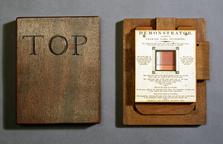









Teaching Soroban Japanese abacus, plastic with 11 digit and stand. Purchased from Association of Teachers of Mathematics, 2001.
By the late 20th century the abacus was attracting interest as a teaching instrument. This example was purchased from the Association of Teachers of Mathematics in 2001. The beads in the sum are pushed to the horizontal bar; the upper beads are worth five and the lower beads one. This is a Japanese abacus or soroban which operates in base 10. It is believed the mechanical movement of beads representing numbers helps understanding.
Details
- Category:
- Mathematics
- Object Number:
- 2001-280
- Measurements:
-
overall (estimate): 250 x 400 x 100 mm
- type:
- teaching abacus
- credit:
- Association of teachers of Mathematics



